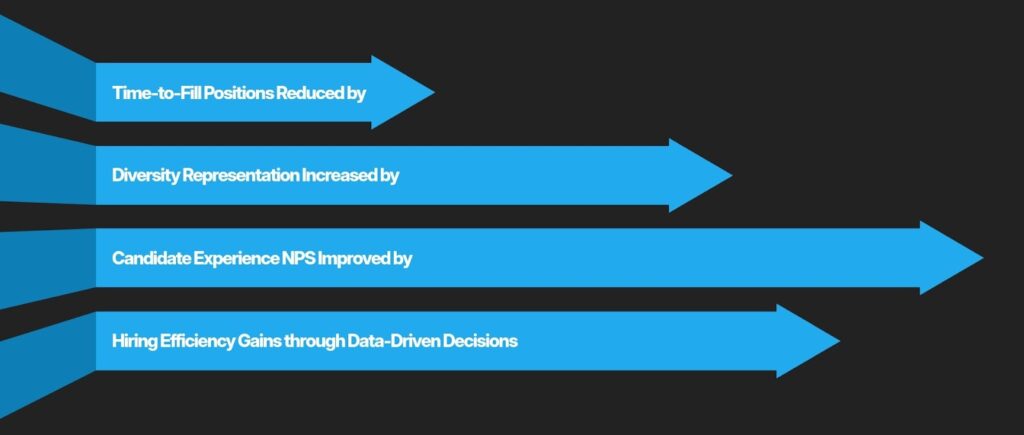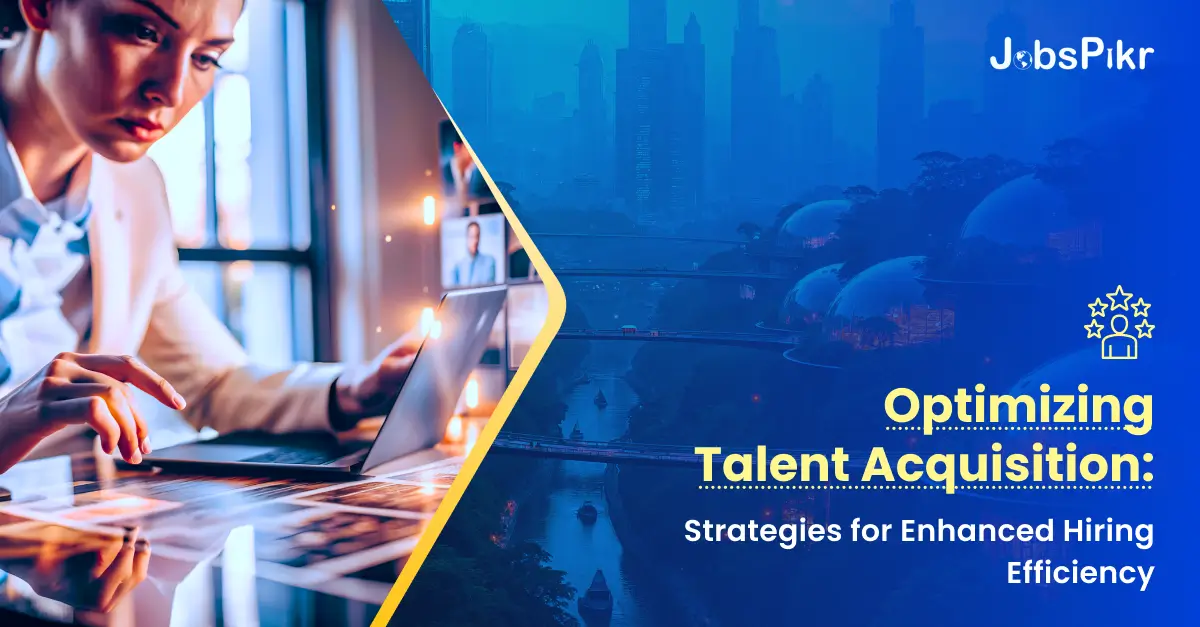Hiring talent has always been one of the most critical parts of building a business but in today’s fast-moving and unpredictable market, traditional recruitment methods aren’t cutting it anymore. Companies are under pressure to find the right people faster, with fewer resources, while also prioritizing diversity and long-term fit.
Why It’s Time to Rethink Talent Acquisition Strategy? As we move through 2025, enterprises across the globe are rethinking their talent acquisition strategy to make it more efficient, inclusive, and scalable. The shift is being driven by a few key realities: a tightening global labor market, increasing competition for niche skills, rising expectations around candidate experience, and the push for more inclusive, data-backed hiring practices.
The big question is—how do you speed up hiring without compromising on quality or culture? And how can you ensure that your recruitment engine is aligned with both business needs and evolving workforce expectations?
The answer lies in adopting a smarter, data-led, and globally adaptable approach to talent acquisition—one that blends speed, insight, and inclusivity at every step. In this article, we’ll explore how companies are modernizing their global talent acquisition strategy, and how platforms like JobsPikr are supporting hiring teams with real-time market intelligence.
The Growing Pressure to Hire Faster (and Smarter)
Speed is now a competitive advantage when it comes to hiring. According to SHRM, the average time-to-fill position in the U.S. is 36 days—but that number jumps significantly for technical and leadership roles. In many cases, top candidates are off the market in just 10 days.
This mismatch puts recruiters in a tough spot. The longer a role stays open, the higher the cost—not just financially, but also in terms of lost productivity and delayed projects. That’s why more companies are doubling down on strategies that reduce time-to-hire without sacrificing candidate quality.

A modern talent acquisition strategy includes the ability to:
- Identify talent gaps early through workforce planning
- Streamline job descriptions and hiring criteria
- Leverage sourcing automation and AI for candidate screening
- Use predictive analytics to prioritize high-fit candidates
But it’s not just about speed. It’s about focus—making sure your team is spending more time with the right candidates and less time sifting through mismatches. This is where platforms like JobsPikr bring real value. By providing labor market data and hiring benchmarks, JobsPikr helps hiring teams identify talent availability, demand trends, and salary expectations—so they can fine-tune roles and reach better candidates, faster.
Building a Global Talent Acquisition Strategy for Scalability
In today’s digital-first world, talent isn’t bound by borders—and neither should your recruitment strategy be.
The rise of remote and hybrid work has opened up access to global talent pools like never before. That’s a major opportunity, but it also introduces complexity. Different markets have different cultural norms, compensation expectations, and availability of skills. A global talent acquisition strategy has to account for all of this.
Scalability comes from structure. Enterprises that succeed at global hiring often invest in:
- Local labor market research to understand regional dynamics
- Location-based talent mapping to decide where to hire from
- Standardized but flexible interview processes across geographies
- Technology platforms that centralize recruitment workflows
For example, a company expanding into Southeast Asia may use labor market analytics to assess which countries offer the best access to engineers, at competitive rates, with acceptable time zones. By layering this insight with internal workforce needs, the company can make smarter decisions around where and how to scale hiring.
JobsPikr’s labor market intelligence platform provides this kind of data in real time, helping companies shape their global talent acquisition strategies with confidence. Whether you’re hiring locally or across borders, understanding talent trends in specific markets is key to staying competitive.
Redesigning Candidate Experience to Boost Conversion
Efficiency in hiring isn’t just about internal processes—it also depends heavily on the candidate’s experience. If your recruitment journey is clunky, slow, or unclear, you risk losing great candidates before you’ve had a chance to evaluate them.
That’s why leading organizations are putting candidate experience at the heart of their talent acquisition strategy. They know that every interaction—job ad, email, interview, offer—shapes the way a candidate views their brand.
A frictionless experience tends to include:
- Clear and inclusive job descriptions
- Easy application workflows (especially mobile-friendly)
- Prompt communication and regular status updates
- Interviewers who are well-prepared and respectful of candidate time
Candidate experience also plays a vital role in improving diversity. When hiring processes are transparent and inclusive, underrepresented candidates are more likely to apply, engage, and accept offers. This makes it a critical part of modern DEI hiring practices.
By using real-time feedback and analytics, companies can refine every touchpoint. Some are even using net promoter scores (NPS) for candidates to track experience quality and drive continuous improvement.
Embedding DEI into Every Stage of the Hiring Funnel
Diversity, equity, and inclusion (DEI) are no longer standalone HR goals—they’re foundational to any successful talent acquisition strategy. But achieving real diversity requires more than broad goals or one-time initiatives. It means building fairness and inclusivity into every step of the hiring process.
This includes:
- Writing job descriptions that remove biased language
- Sourcing from a broader set of schools, platforms, and communities
- Using structured interviews to reduce bias
- Tracking and analyzing hiring data by gender, ethnicity, and background
DEI hiring practices must be proactive. It’s not enough to wait for diverse candidates to apply—you have to go out and find them. Companies that are serious about equity are using analytics tools to track where they’re losing candidates in the funnel, and why.
For instance, if you notice a sharp drop-off after the first interview among a certain demographic, it’s a signal that something in the process might be creating barriers. Whether it’s unconscious bias in interviewer behavior or a lack of cultural alignment, the insight gives you a chance to fix it.
JobsPikr helps teams understand external talent diversity across markets, allowing companies to set realistic DEI goals, track representation benchmarks, and close the gaps. When DEI is built into your strategy—not added on as an afterthought—retention and employee satisfaction improve alongside hiring outcomes.
Using Analytics to Reduce Time-to-Hire and Improve Quality
Data is the engine behind every high-performing talent acquisition strategy today. From measuring sourcing effectiveness to predicting candidate success, analytics help teams make decisions based on facts, not just instinct.
One of the most measurable impacts of data is on time-to-hire. When hiring teams know which channels work best, what job titles attract better talent, and which interviewers tend to move faster, they can adjust accordingly.
For example:
- If candidates from a certain job board consistently move to final rounds, that source can be prioritized.
- If some roles always take longer to fill, analytics can highlight bottlenecks—like delayed feedback or misaligned criteria.
- If offers are being rejected often, data can reveal whether salary, role clarity, or timelines are the issue.
This kind of insight isn’t always easy to gather manually, especially in large or multi-location hiring teams. That’s why integrating a platform like JobsPikr—which pulls labor market benchmarks and competitor hiring trends—gives an added edge.
When hiring decisions are based on real-time data rather than assumptions, efficiency improves naturally.
Aligning Hiring Goals with Long-Term Business Strategy
Too often, recruiting teams operate separately from strategic business planning. But in today’s environment, where talent directly fuels growth, this separation creates risk.
The most advanced companies are integrating talent acquisition into their larger business strategy. This means HR leaders are working alongside finance, operations, and product teams to forecast hiring needs, plan capacity, and build pipelines in advance.
Aligning hiring with business goals also ensures:
- You’re not scrambling to fill roles after the need arises
- You hire for future potential, not just immediate fit
- You’re more thoughtful about location, budget, and team design

For example, if the product team plans to launch a new AI feature in Q3, hiring for machine learning roles should start in Q1. With this alignment, hiring becomes a growth enabler—not a bottleneck.
JobsPikr supports this with workforce planning and predictive demand forecasting, making it easier to link talent strategy with organizational roadmaps. When everyone’s on the same page, hiring becomes faster, more strategic, and less reactive.
Tech and Tools Powering Modern Talent Acquisition
The evolution of talent acquisition wouldn’t be possible without technology. Today’s recruiting teams rely on a growing stack of tools—from ATS systems and video interview platforms to labor market intelligence engines and sourcing automation software.
However, tools alone aren’t enough. What matters is integration and insight. Hiring platforms need to talk to each other, and data needs to flow smoothly across the funnel.
Some must-have capabilities include:
- Candidate relationship management (CRM)
- AI-powered resume screening and matching
- Interview scheduling automation
- Labor market analytics and competitive benchmarking
- DEI data tracking and compliance monitoring
JobsPikr integrates with hiring platforms to offer macro-level insights, helping teams not only manage talent pipelines, but also understand broader hiring trends, competitor moves, and market shifts. This real-time intelligence layer allows for smarter hiring at scale.
Redefining Talent Acquisition for the Future of Work
The landscape of talent is shifting—fast. Between rising expectations, global hiring demands, and the pressure to do more with less, recruitment teams are being asked to rethink how they operate.
A future-ready talent acquisition strategy is:
- Data-driven and insight-rich
- Inclusive by design
- Built for speed, but without sacrificing quality
- Flexible enough to scale across geographies
- Aligned tightly with business growth and workforce planning
To get there, HR leaders must embrace analytics, invest in experience, and lean into technology that makes hiring more human—not less.If you’re ready to bring greater speed, precision, and inclusivity into your hiring approach, sign up on JobsPikr. Our talent intelligence platform helps you understand markets better, plan smarter, and hire with confidence—no matter where or what you’re hiring for.



